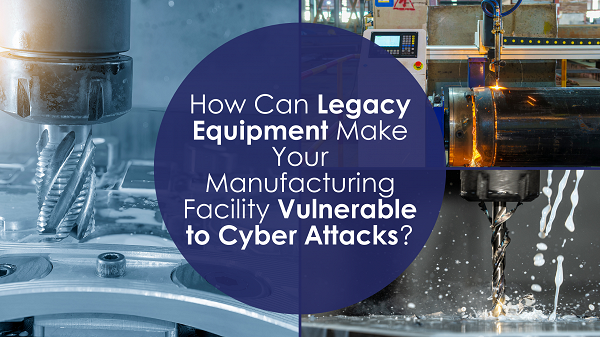How Can Legacy Equipment Make Your Manufacturing Facility Vulnerable to Cyber Attacks?

Picture this: You’ve invested years in perfecting your manufacturing processes, fine-tuning equipment, and streamlining operations. Your facility hums with the efficiency of well-oiled machinery. But lurking beneath this veneer of productivity is a hidden threat that could bring everything grinding to a halt - your legacy equipment.
While these trusted workhorses have served you well, they may now be your Achilles’ heel in the face of modern cyber threats. Let’s explore how legacy equipment can leave your manufacturing facility exposed and what you can do about it.
Outdated Software and Firmware
One of the primary vulnerabilities of legacy equipment is outdated software and firmware. These systems often run on older versions that are no longer supported by the manufacturer. This lack of support means no security patches or updates are available, leaving your equipment exposed to known vulnerabilities. Cybercriminals exploit these weaknesses, gaining access to your network, stealing sensitive data, or disrupting your operations.
Solution: Regularly update all software and firmware. If updates are no longer available, consider integrating additional security measures or replacing the equipment with newer, more secure alternatives.
Other blogs you may be interested in:
- Understanding the Hidden Cost of Criminal Activity on Manufacturing Efficiency
- What Are the Risks of Using Outdated Machinery in Manufacturing?
Incompatibility with Modern Security Solutions
Legacy equipment is often incompatible with modern security solutions. These machines were not designed with today’s cyber threats in mind and integrating them into a secure network can be challenging. They may lack the necessary interfaces to support current encryption standards, firewalls, or intrusion detection systems, creating gaps in your security infrastructure.
Solution: Conduct a thorough assessment of your equipment to identify vulnerabilities. Implement network segmentation to isolate legacy systems from critical infrastructure. This minimises the risk of a breach spreading across your entire network.
Other blogs you may be interested in:
Physical Security Vulnerabilities
Older machines can also pose physical security risks. They might lack modern access controls, making it easier for unauthorised personnel to tamper with them. Physical breaches can lead to operational disruptions, data theft, or sabotage, further compounding the risks posed by cyber threats.
Solution: Enhance physical security measures around legacy equipment. Use surveillance cameras, access controls, and regular security audits to ensure these machines are protected from unauthorised access.
Other blogs you may be interested in:
- Making the Right Choice: Why Core Values Matter in Your Security Partner
- Securing your business with legacy equipment: Why choose our expertise?
Proactive Measures for a Secure Future
Legacy equipment can significantly impact the security of your manufacturing facility, leaving you vulnerable to both cyber and physical attacks. However, by understanding these risks and taking proactive measures, you can mitigate potential threats. Regular updates, compatibility assessments, and enhanced physical security are essential steps in protecting your operations.
At Equilibrium Risk, we specialise in helping manufacturers secure their facilities against modern threats. By partnering with us, you can ensure that your legacy equipment is not a weak link in your security chain. Learn more about how we can help you safeguard your operations and maintain a secure manufacturing environment.
Your business’s security is our priority. Let’s work together to protect your legacy while securing your future.
This content has been generated with the assistance of artificial intelligence (AI). While AI technology was used to draft and develop the initial content, it has been thoroughly reviewed, edited, and fact checked by Luke to ensure accuracy and relevance. We strive to provide high-quality and trustworthy information, but please be aware that AI-generated content may contain errors or omissions. We take full responsibility for the final content presented here and are committed to maintaining transparency and integrity in our use of AI technology.





